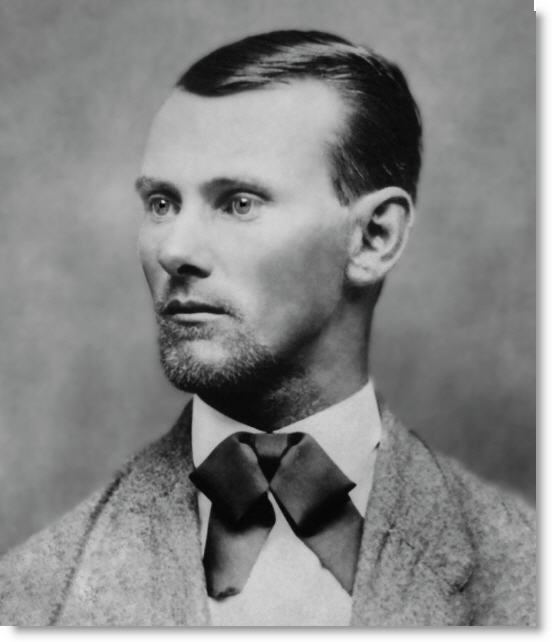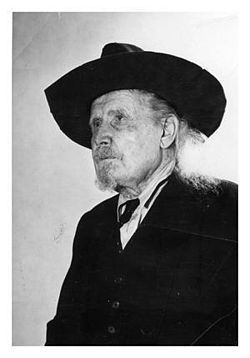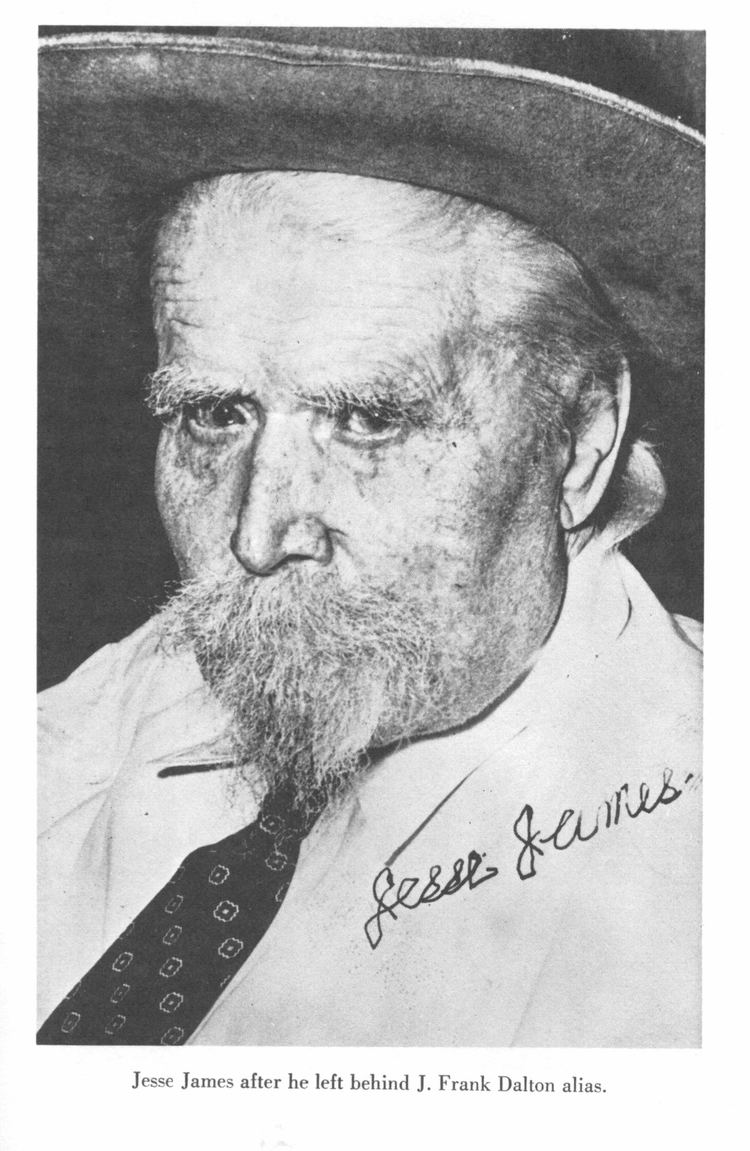Name J. Dalton | ||
 | ||
Born March 8, 1848 Goliad, Goliad County, Texas Died August 15, 1951, Granbury, Texas, United States | ||
J frank dalton 1948
John Frank Dalton (March 8, 1848 – August 15, 1951) was a man who, in the last few years (1948-1951) of his long life, publicly claimed to be the famous outlaw Jesse James. However, most professional historians believe that Dalton was merely a Jesse James impostor, and that the real Jesse James was killed by Robert "Bob" Ford on April 3, 1882, in Jesse's rented home at 1318 Lafayette Street in St. Joseph, Missouri.
Contents
- J frank dalton 1948
- Possibility of the name J Frank Dalton being an alias
- What Dalton said about himself and Jesse James in The Crittenden Memoirs 1936
- Dalton surfaces as Jesse James in his affidavit of May 19 1948
- Robert Ruark interviews Dalton in June 1949
- The Mt Olivet Cemetery exhumation July 1719 1995
- The Granbury Cemetery exhumation May 30 2000
- References

With the death of Jesse James in 1882, and the subsequent death of his wife Julia Ellen Groshon during childbirth in 1886, J. Frank Dalton abandoned his children and began roaming the countryside. In the 1930s and 1940s he appeared in Independence County, Arkansas, telling tales of being Jesse James, and on other occasions he told tales of being the famous Western lawman John Franklin "Frank" Dalton (June 8, 1859 - November 27, 1887), thus earning himself a meal. By the 1940s he was in Oklahoma and Texas, where his uncle lived and he had relatives. It was in Texas that he first claimed he was the same Frank Dalton who historians believe had been killed in 1887. When it was proved that he wasn't the original Frank Dalton (1859-1887), in April, 1948 - in Lawton, Oklahoma - he took up being Jesse James instead.
Dalton was allegedly 100 years old at the time of his first public appearance as Jesse James - at Lawton, Oklahoma in April–May, 1948. Like the real Jesse James, Dalton apparently had been a pro-Confederate guerrilla in Missouri during the Civil War. However, Dalton's account of himself as Jesse James did not hold up under questioning from Jesse James' surviving relatives.

Nevertheless, several people of note, such as journalist/novelist Robert Ruark, were convinced that J. Frank Dalton was the famous outlaw Jesse Woodson James. To many people's surprise, Dalton did appear to have many of the unique body marks/body features which the real Jesse James was rumored to have. These body features included: seven bullet wounds, a rope burn around his neck, a collapsed lung, a damaged fingertip, and severely burned feet.

On September 5, 1949, Rudi Turilli and Lester B. Dill (the general manager and owner, respectively, of Meramec Caverns, near Stanton, Missouri) hosted a reunion at Meramec Caverns for Dalton and his last-remaining old-time friends, in celebration of Dalton's/Jesse James' supposed 102nd birthday.

J. Frank Dalton died on August 15, 1951, in Granbury, Texas, and his death certificate was recorded with the name of the man he claimed to be. His gravestone in Granbury Cemetery also has that claimed identity recorded on it.
Possibility of the name "J. Frank Dalton" being an alias
Considerable evidence exists that the name "J. Frank Dalton" (in full: John Frank Dalton) was itself just an alias that this man used. While a resident of the Roper Hotel in Marble Falls, Texas, in the 1940s, J. Frank Dalton claimed to be the presumed dead Frank Dalton, a U.S. Marshall for the Oklahoma Territory under Judge Isaac Charles Parker. The original Frank Dalton was the older brother to the infamous Dalton Gang members and a touring member of Wild Bill Hickok’s Wild West show. The real Frank Dalton was believed to have died Nov. 27, 1887 while in the line of duty.
What Dalton said about himself and Jesse James in The Crittenden Memoirs (1936)
In The Crittenden Memoirs (1936), a man who refers to himself as "Frank Dalton" writes in detail about the death of Jesse James, claiming that he (Dalton) was present when reporters, law enforcement officers, and locals gathered to witness the scene, and where Bob Ford confessed. Dalton demonstrates an awareness of the general lack of understanding surrounding the details of the death:
"Why was Jesse James killed? Why was it thought by many that the man killed by Bob Ford was not Jesse James? Why did Aunt Zerelda (Jesse's mother) at first deny that the murdered man was her boy? These things have never been told at all, or grossly misrepresented in the telling." Dalton goes on to say that he is aware of others' efforts to pose as Jesse, saying:
"Of course, Jesse has been seen alive from time to time by cheap notoriety seekers. Once a cowboy came up from the Argentine and said that Jesse was ranching and doing well down there. When this report was sifted down, it was found that the man taken for Jesse was a younger son of an English lord. A few years ago a banker in a West Texas town died, and the report was spread that he was Jesse James. More recently a fellow popped up claiming to be Jesse! How the heck do they get that way, loco weed, or what? No! Jesse James was killed by Bob Ford on the 3rd of April, 1882, in St. Joseph, Mo., there were too many people who knew him well and came to identify him for there to be any possible doubt, so that is that." It is not clear whether the "Frank Dalton" of The Crittenden Memoirs and J. Frank Dalton were the same person, but the evidence and self-declared inside knowledge strongly suggest they were.
Dalton surfaces as Jesse James in his affidavit of May 19, 1948
The following affidavit (signed by J. Frank Dalton in the presence of Reece L. Russell, notary public, in Lawton, Oklahoma on April 24, 1948) appeared in full on the front page of The Lawton Constitution newspaper, issue of Wednesday, May 19, 1948:
KNOW ALL MEN BY THESE PRESENTS: That I, J. Frank Dalton, being of sound mind and body, wish to state that I am the son of Robert James, a Baptist minister, and Zerelda Cole, and that I was born at Centerville, Missouri, on September 5, 1847. The town of Centerville was later changed to Kearney, Missouri, same being located and situated in the present County of Clay, the State of Missouri. I have used many different names and aliases over many years, but my real name is and always has been JESSE WOODSON JAMES. My full brother was ALEXANDER FRANK JAMES, four years older than myself. We were members of QUANTRILL'S MISSOURI IRREGULARS that fought through the Civil War on the side of the Confederacy, later we became outlaws or bandits who operated over a wide area of several states.
IN WITNESS WHEREOF, I hereunto set my hand and seal this the 24th day of April, 1948.
(Signed) J. Frank Dalton
Robert Ruark interviews Dalton in June 1949
Ever since the time of the murder on April 3, 1882, there has been a small but steady stream of witnesses and researchers who believe that Jesse James faked his death in 1882 and then adopted an alias. The majority of those who subscribe to this "murder hoax" theory believe the real murder victim was Charles "Charley" Bigelow, an undercover Pinkerton detective who was posing as Jesse James and committing robberies - thus incurring the wrath and vengeance of the real Jesse James. This theory holds that there was a "murder hoax conspiracy" involving several people (all close friends of the real Jesse James), who conspired together to murder someone, and who then all swore before the investigating officials that the murder victim was Jesse James. The goal of the conspirators was to manipulate and/or "control" the murder evidence in such a way that the law enforcement and judicial authorities involved in investigating the murder would certify that Jesse was legally dead, thus setting Jesse James free.
In 1949, J. Frank Dalton was living in a cabin on the grounds of Meramec Caverns, courtesy of Lester B. Dill who owned the caverns. In June 1949 the journalist Robert C. Ruark interviewed Dalton there, and then published some of what Dalton told him in a series of 3 newspaper articles which were published in early July 1949 in newspapers across the United States. Following is what J. Frank Dalton told Ruark concerning the Jesse James murder hoax. This information is excerpted verbatim from Ruark's article titled "Uncle Jesse Looks and Acts Like Real James" (The Evening Independent, St. Petersburg, Florida, July 9, 1949, p. 10):
"Stanton, Mo. - The old man who looks, acts, and talks like Jesse James, and who claims, at 102 years of age, to be Jesse James, says that the man who was killed and buried as Jesse James was a fellow named Charlie Bigelow.
. . . The old man says he had him a string of runnin' horses, and two come down with distemper. 'I fetched 'em to St. Joe to isolate 'em,' he said. 'I had a house there I was not usin' for a spell - not until after some runnin' races at Excelsior Springs. This fellow Charlie Bigelow looked enough like me to be my twin, and he was huntin' a house. I told him and his wife they could use my place for a spell, until after the races, and he moved in.
One day I was out in the barn doctorin' my horses when I heard a gunshot in the house. When I heerd that gun go off I knowed it wasn't no play-party, because we argued with guns in them days. I run into the house and there was Bob Ford, standing over Bigelow with a gun in his hand and blood on the floor. I said to Ford, 'Looks like you killed him, Bob,' and Bob says, 'Looks like I did, Jesse.' Then I says, 'This is my chance, Bob. You tell 'em its me you killed. You tell my mother to say so, and you take care of that Bigelow woman. I'm long gone.'
The old man says he got on one of his horses - a good horse, a four-mile horse - and he lit out. He says he went to Kansas City to Memphis, to New Orleans, where he took a boat for Brazil. He kicked around South America for a spell and came home, and then went to Mexico. He settled later in Oklahoma, and claims to have been elected, under the name of J. Frank Dalton, to the territorial legislature. He later moved to Texas."
The Mt. Olivet Cemetery exhumation (July 17–19, 1995)
In recent years there have been a few attempts to resolve these historical mysteries and to finally get to the real truth of the matter. Unfortunately, none of these attempts have produced any evidence which can definitively resolve the issues being debated by the contending parties.
For example, on July 17–19, 1995, James E. Starrs (David B. Weaver Research Professor of Law, and Professor of Forensic Sciences, at George Washington University Law School) supervised the exhumation of Jesse James' purported grave in Mt. Olivet Cemetery at Kearney, Clay County, Missouri.
Here are the statements of Starrs and his colleagues on this subject, quoted verbatim from their report (page 175): ". . . We are left with three possibilities: (1) the exhumed remains are indeed those of Jesse James; (2) the exhumed remains are not Jesse James, but from another maternal relative of RJ and MN; or (3) the exhumed remains are from an unrelated individual who, by chance, happens to have the same mtDNA sequence as RJ and MN . . . Do the mtDNA results prove that the exhumed remains are those of Jesse James? The answer to this question must be no, as there is always the possibility (however remote) that the remains are from a different maternal relative of RJ and MN, or from an unrelated person with the same mtDNA sequence. However, it should be emphasized that the mtDNA results are in complete agreement with the other scientific investigations of the exhumed remains: there is no scientific basis whatsoever for doubting that the exhumed remains are those of Jesse James. The burden of proof now shifts to those who, for whatever reason, choose to still doubt the identification . . ."
However, critics of the exhumation - most notably Betty Dorsett Duke (1947-2015) - claim that the DNA samples obtained and tested by Starrs' exhumation team did not originate from the remains exhumed from the gravesite. Duke and many other critics of this exhumation have pointed out that, according to the canons of forensic science, the "chain of custody" of the actual remains which yielded the DNA samples tested by the Starrs team was not precisely known at the time of the exhumation, and, moreover, that the "chain of custody" of those remains cannot now be precisely determined or reconstructed through further investigation. Consequently, the critics of the exhumation believe that the primary conclusion the Starrs team published in their report (quoted above) cannot be relied on with any degree of confidence. Going even further, in view of all the evidence which has emerged (since the time of the exhumation) which contradicts the basic conclusion of the Starrs exhumation team, many critics of the exhumation now believe that the primary conclusion of the Starrs exhumation team (as quoted above) is simply false.
The Granbury Cemetery exhumation (May 30, 2000)
Bud Hardcastle - an amateur historian and used car salesman from Purcell, Oklahoma, and a long-time researcher of the Jesse James/J. Frank Dalton mystery - is one of those who (for several reasons) has been unwilling to accept the conclusions of the Starrs exhumation team. In the mid-1990s, Hardcastle joined forces with three sons of Jesse Cole James. These brothers - Jessie Quanah James, Sr., Burleigh Dale James, and Charles A. James - all believed that Dalton was their grandfather, and that Dalton really was the famous outlaw Jesse James. J. Frank Dalton was buried in the Granbury Cemetery at Granbury, Hood County, Texas. Hardcastle and the three James brothers decided to request an exhumation order from the Hood County (Texas) Court, so they could have Dalton's remains exhumed and DNA-tested in an attempt to determine - once and for all - if Dalton really was Jesse James.
Attorneys for Hardcastle and his associates filed a request for an exhumation order with the Hood County Clerk's Office on June 14, 1996. At the exhumation hearing held in September 1996, Hood County judge Don Cleveland denied their request, ruling that the attorneys had not provided him with any compelling evidence as to why he should approve the request. On July 20, 1999, Hardcastle's attorney Steven J. Reid filed a second request for an exhumation order with the Hood County Clerk's Office. It appears that after filing the second request on July 20, 1999, attorney Reid filed at least one "Amended Application for Exhumation." These "amended applications" contained detailed genealogical and historical information which Hardcastle and his associates considered to be the "compelling evidence" which Judge Cleveland had stated was lacking at the time of the first exhumation hearing in September 1996. Hood County judge Linda Ray Steen approved this request at an exhumation hearing held on February 17, 2000.
